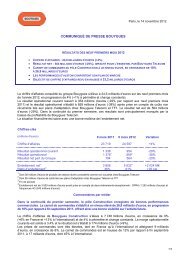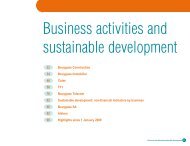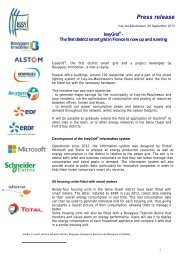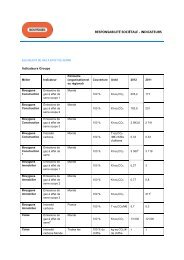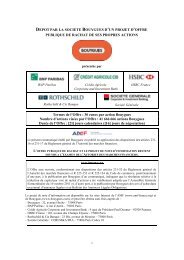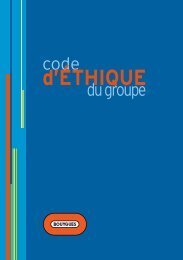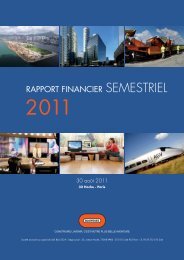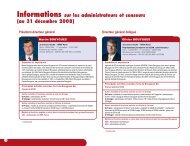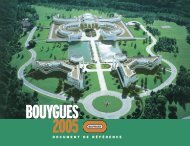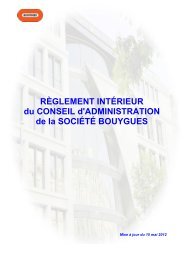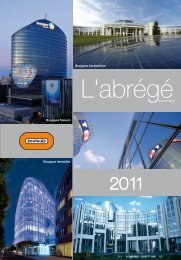A N N U A L R E P O R T - Bouygues
A N N U A L R E P O R T - Bouygues
A N N U A L R E P O R T - Bouygues
Create successful ePaper yourself
Turn your PDF publications into a flip-book with our unique Google optimized e-Paper software.
dual exchange rate risk arising from<br />
commercial transactions. When cash<br />
flows are certain, exchange rate risk<br />
is covered by forward purchases and<br />
sales or by currency swaps. For some<br />
major projects, a hedge using currency<br />
options may be put in place before<br />
the contract is finally concluded.<br />
As with exchange rate risk, and likewise<br />
for rationalisation purposes, the<br />
interest rate positions of some Group<br />
entities may be managed centrally and<br />
partially offset against each other.<br />
Accounting methods<br />
If the euro were to depreciate by<br />
1% against all other currencies, the<br />
market value of the portfolio would be<br />
+€4 million.<br />
Values have been calculated by the<br />
Group or obtained from the bank<br />
counterparties to the contracts.<br />
Equity interests in foreign companies<br />
are generally covered by debt of a<br />
comparable amount in the same currency<br />
on the books of the companies<br />
holding the interests in question.<br />
As a general rule the Group uses<br />
hedge accounting for its hedging<br />
instruments. Hedge documentation is<br />
prepared in accordance with IAS 39<br />
and one of two methods is used to<br />
account for hedging instruments:<br />
For rationalisation purposes, the foreign<br />
exchange position of some Group<br />
entities may be managed centrally<br />
so that symmetrical positions can be<br />
offset against each other.<br />
■ Interest rate risk<br />
The principle is to hedge all or some of<br />
the foreseeable and recurring financial<br />
assets and liabilities at the level<br />
of each sub-group.<br />
In practice, the entities that hedge<br />
interest rate risk are those whose<br />
business is capital-intensive by nature<br />
(telecom and media). These entities<br />
secure their future financial position<br />
by fixing the cost of their debt with<br />
swaps and FRAs or by limiting it with<br />
caps for a period of time linked to<br />
the maturity of the financial liabilities<br />
being hedged.<br />
• fair value hedge: changes in the fair<br />
value of the hedging instrument and<br />
the hedged item are recognised symmetrically<br />
in the income statement;<br />
• cash flow hedge: the ineffective part<br />
of the change in the fair value of the<br />
hedging instrument is recognised<br />
in the income statement and the<br />
effective part in shareholders’ equity<br />
(until the transaction is unwound).<br />
In a few cases, such as when the<br />
notional amount is small or the maturity<br />
is short, it is Group policy not to<br />
use hedge accounting so as to avoid<br />
cumbersome administrative procedures.<br />
In such cases, any change in the<br />
fair value of the hedging instrument is<br />
recognised in the income statement.<br />
Market value of<br />
hedging instruments<br />
At 31 December 2005, the market<br />
value (net present value) of the portfolio<br />
of hedging instruments was +€9<br />
million (1) . This amount consists mainly<br />
of the net present value of interest<br />
rate swaps to hedge the Group’s debt<br />
(fair value and cash flow hedges) and<br />
the net present value of forward transactions<br />
to hedge the currency risk on<br />
commercial transactions.<br />
The market value by type of hedge<br />
was as follows:<br />
• transactions as part of a fair value<br />
hedge: +€14 million,<br />
• transactions as part of a cash flow<br />
hedge: -€5 million.<br />
If the yield curve were to shift upward<br />
(downward) by one percentage point,<br />
the market value of the portfolio of<br />
hedging instruments would be respectively<br />
+€5 million (+€12 million).<br />
(1) Including Colas for -€9 million. The impact of the market value of the interest rate swap taken out by Colas’ UK subsidiary for the Portsmouth contract (-€9 million) is entirely offset by the market value<br />
of the derivative incorporated into the contractual flat fee paid by the customer (+€9 million).<br />
SUSTAINABLE DEVELOPMENT<br />
95



